Social networks in Russia, spring 2015. Figures, trends, forecasts
We present new data from the research cycle “Social networks in Russia today: numbers, trends, forecasts” for the first half of 2015. The sixth regular publication contains relevant data on social media penetration by regions of Russia, demographic analysis of the audience, and the dynamics of publication activity in social networks.
One of the key indicators of the “vital activity” of a social network is the number of “talking” users who openly express their position with public messages in social media. Such active authors in April 2015 in Russia were about 35 million people who generated almost 620 million messages in a month. Active authors, creating public content, make social networks a relevant indicator of public sentiment, allowing you to catch the "live" social problems at the very beginning of the formation of significant trends.
By the number of “writing” Russian authors, VKontakte leads, almost by an order of magnitude ahead of its competitors - 21.6 million unique authors. The following Instagram is on the second place - only 2.4 million authors (a decline in relation to the data of the past half year was 11%, the pre-New Year activity remained insurmountable peak height). The third place - Twitter - showed a significant drop (-24% by November 2014), speaking authors in April 2015 recorded only 1.6 million people.
')

* Data on the Odnoklassniki social network are based on statistics of the TOP 100.000 groups
As for the volume of content posted daily in social networks, here the first place belongs to the social network VKontakte, followed by Twitter.
It is worth noting that, compared with the trends of winter, where Twitter dominated, in the spring, VKontakte took revenge, having overtaken microblogs by 42%! This is due to the greater versatility of the VKontakte publication format - users not only record current moods in the form of short statuses (similar to tweets) on their pages, but also write detailed reports with photos and videos, share interesting news and useful tips.

* Data on the Odnoklassniki social network are based on statistics of the TOP 100.000 groups
Twitter is traditionally leading in terms of engagement - there is a machine-gun burst of 127 posts per month for one active author on this network. The second place - LiveJournal - lags behind by this indicator more than 3 times (on average, 40 messages per author): this is exactly the case when the quantity turns into quality. It is worth noting the explosive growth in the involvement of Facebook (a threefold increase compared to the winter data), which took 3rd place with 32 posts per month for the author. The level of involvement in other social networks ranges from 13.4 (VKontakte) to 6.3 (My World).

* Data on the Odnoklassniki social network are based on statistics of the TOP 100.000 groups
Monthly social media audience
According to TNS, the monthly audience of most social networks has stabilized. So, the VKontakte audience stopped at 53.6 million people, the second place went to Odnoklassniki ( 38.8 million people). Facebook audience in April was 24.5 million people, My World was close to it - 23.7 million people, Instagram audience in April was 10, 7 million people. Twitter showed a decline of 13% - its audience in April is 7.4 million .
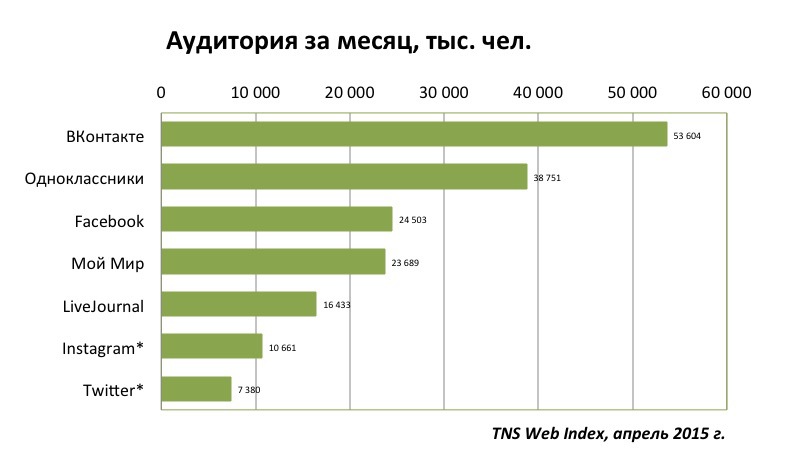
* Twitter and Instagram data are extrapolated based on daily per day and frequency of visits per month.
The monthly audience * - 53.6 million people , 40% of which - 21.6 million - showed public activity.

The gender structure of the VKontakte authors is fairly stable, 41.9% of the authors are male, the proportion of the weaker sex was 58.1% .
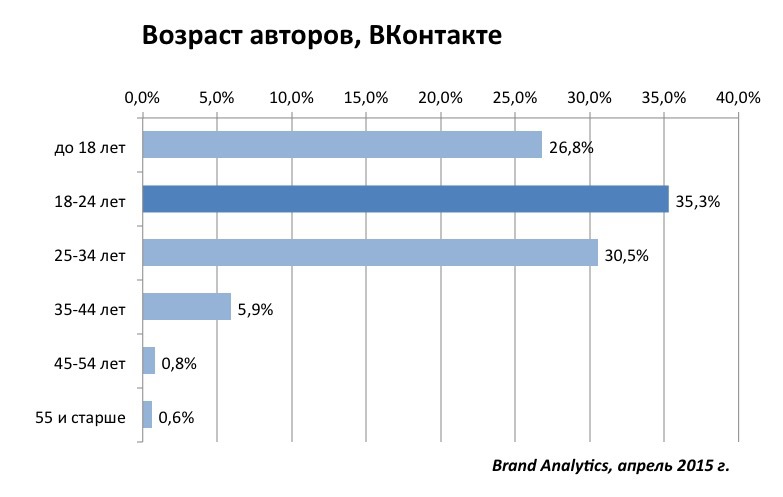
Compared with the December data, the age structure of the VKontakte audience has smoothed out - although the main backbone of users is also included in the category “from 18 to 24 years old”, their share decreased by 2.5 percentage points, while the groups of teenagers were replenished (+2.8%). . p.) and a mature contingent over 45 years of age (+1.4 pp).

In general, the geographic slice of the VKontakte audience in the spring of 2015 follows the contours of winter - St. Petersburg ranks first with a network penetration rate of 36%, Moscow is second with 26% of the registered population. However, in most regions there is an alarming reduction in the penetration rate of the most popular Russian-language network. It is worth noting that the emergence of Sevastopol in the top five of the most "mastered" regions (4th place with 23% of the registered population).
Classmates, as before, remain primarily a platform for interpersonal communication. The monthly audience * of the network is 39 million people , while only 1.4 million authors demonstrate public activity in groups .

Compared to the winter in April, the share of women in the Odnoklassniki gender structure has slightly decreased - however, the predominance of the weaker sex is still large (69.2% of women versus 20.8% of men).
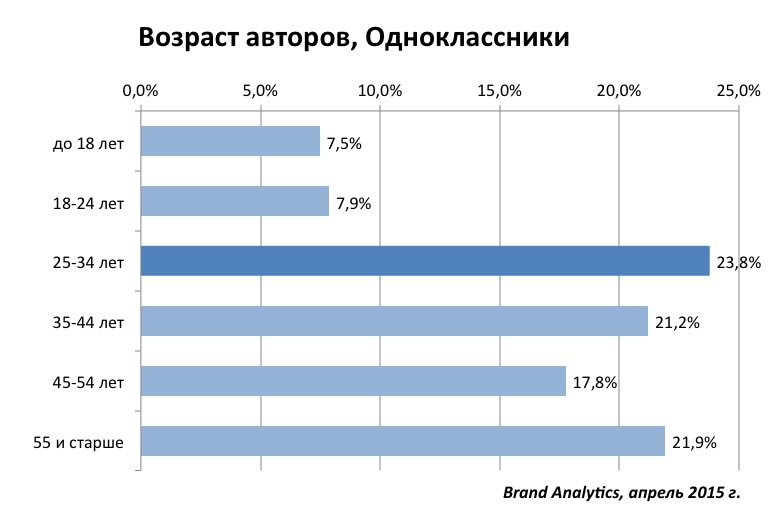
In spring, Odnoklassniki retain the trend of “growing up” the audience: the share of authors older than 55 in April 2015 increased by 2.1 percentage points, the category “from 45 to 54 years old” increased by 0.8 percentage points, and the group “ from 35 to 44 years old "added 1.2 percentage points Users under 24 years old decreased by 4 percentage points. in the age structure of the network.
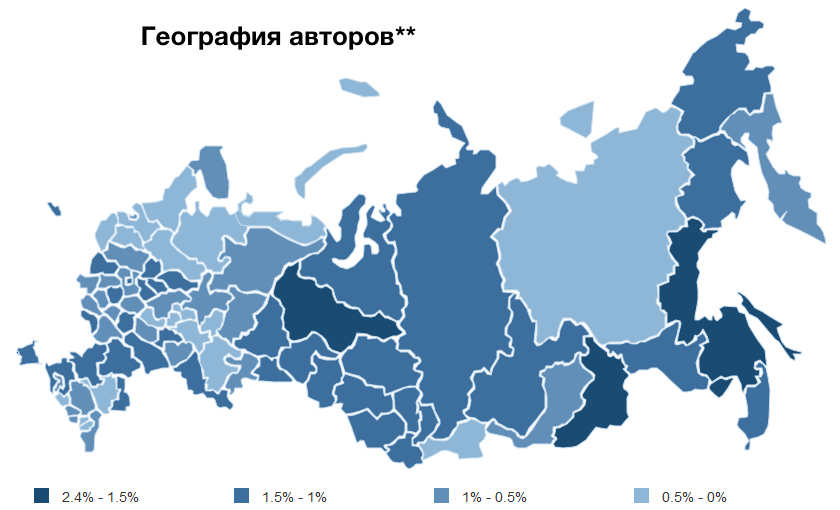
Classmates remain the "regional" social network of Russia: the first place in terms of network penetration, as before, belongs to the Sakhalin Region. Next come the Jewish Autonomous Region and the Khabarovsk Territory.
The monthly audience of the network * was 23.6 million people , and the number of active authors was 1 million people .

The gender structure of My World has practically not changed, 39.9% of men and 60.1% of women.
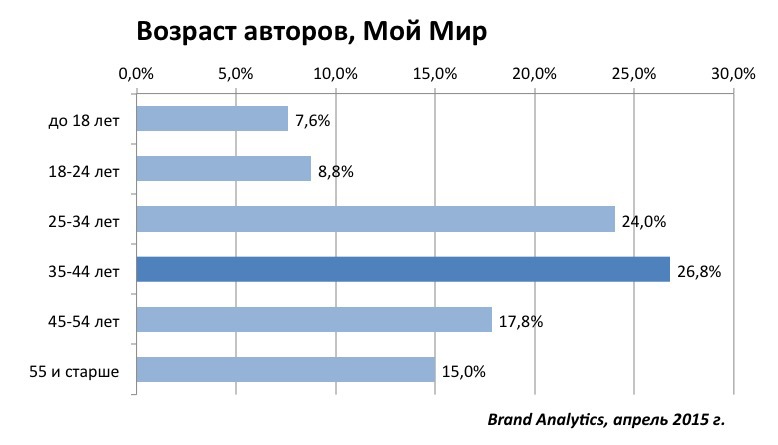
In the age distribution of the authors of the My World network, there was a strengthening of middle age groups: the share of the category “from 25 to 34 years old” increased by 1.7 percentage points. , and the share of the category “from 35 to 44 years old” increased by 3.8 percentage points .

As before, the Chelyabinsk Region (1.67% of the population) is the leader in the rating of regions in terms of the penetration of the Moy Mir network, but in the spring Moscow pushed aside Sevastopol (1.32%) from second place.
Facebook
On Facebook, the share of writing authors in the general audience is consistently low: according to April, the monthly audience * of the network was 24.5 million people , of which 1.1 million people showed publication activity. Involvement of an active audience showed unprecedented growth in spring.

Spring shifted the gender distribution of the Russian-speaking part of Facebook towards the weaker sex ( 56.3% of the authors ).
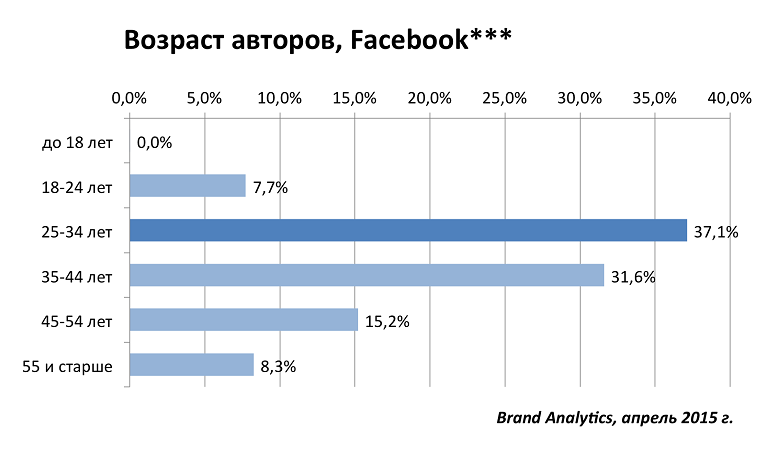
In the age structure of Facebook, the position of the category “from 25 to 34 years old” has strengthened - their share has grown by another 2.2 percentage points. In general, the distribution of Russian-speaking authors of the network is fairly stable in age.
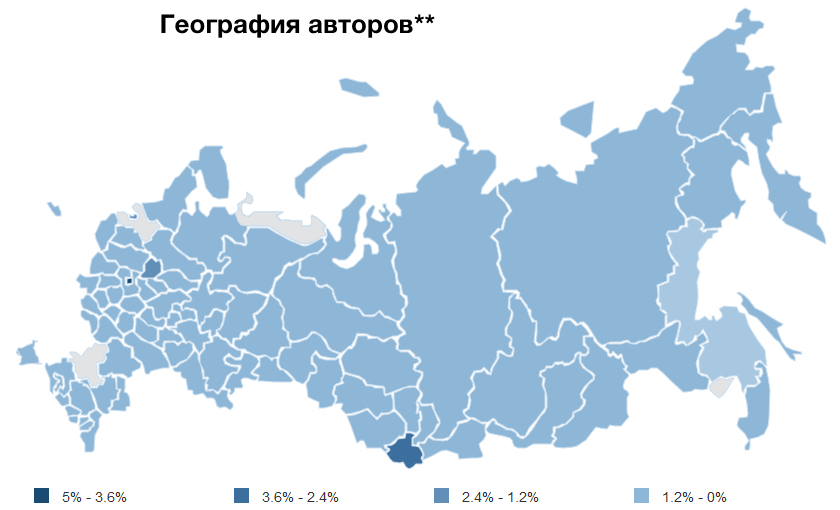
The geographical cut demonstrates stability - most regions retained their December positions: the only vivid exception here is Altai, which rose to second place in terms of Facebook penetration in Russia (3% of the population).
LiveJournal remains a place for “to read, not to talk” lovers: out of 16.4 million people of a monthly audience *, only 123 thousand authors are active.

In LiveJournal, the male audience continues to grow - compared to the winter figures, the share of the stronger sex increased by 1.4 percentage points. Live Magazine can rightly be called the most male social network in Russia: blogs also mark the highest proportion of substantive discussions.
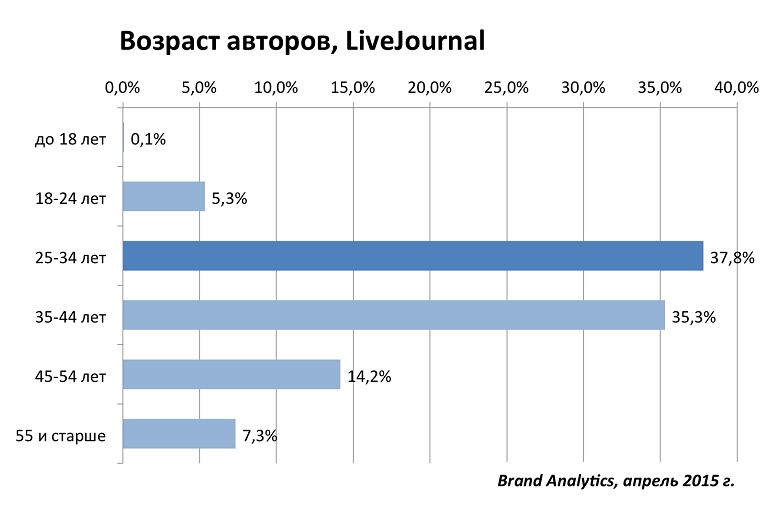
The age structure of LJ has stabilized and a bit “settled down” - the most popular category “from 25 to 34 years old” reduced its presence by 0.5 percentage points. The older groups, on the contrary, grew up: “from 35 to 44 years old” - by 2.1 percentage points, “from 44 to 54 years old” by 1.6 percentage points, and “over 55 years old” added 0.7 pp
Instagram
Instagram, although it retains its superiority over Twitter, in April, slightly losing its position on the audience and the number of authors compared with the winter figures. The monthly audience of the network * was 10.6 million people , and the number of active authors was 2.4 million .

In April, the prevalence of the weaker sex on Instagram increased by almost 7 percentage points. Thus, this network can rightfully be called the most female among Russian-language social media.
Data on the age of active authors in Instagram is missing.

The level of penetration into Instagram almost did not change - Leningrad Oblast, Moscow, Sakhalin and Moscow Oblasts are still leading.
Twitter
If you compare with December, in the spring, Twitter passed the position in Russia. In April, the resource audience * amounted to 7.4 million people , and the number of active authors was 1.6 million .

Interestingly, in April 2015, in comparison with the winter data, the palm moved to the side of the stronger sex (the share of the male audience increased to 50.6%).
Data on the age of active authors on Twitter is missing.

In terms of Twitter penetration leadership returned St. Petersburg. Also in the current ranking in the top three broke Novosibirsk and Novgorod region, and Moscow did not even hit the TOP-5.
VKontakte remains the youngest and most dynamic social network: almost 2/3 of the authors of this network are under 25 years old. The share of the mature contingent "45 and older" accounts for only 1.4% of the active audience, the authors from 35 to 44 years old make up only 6% of the "writing" users. The core of this social network is the age group “from 18 to 24 years old” - 35.3% of the authors.
Traditionally, the most adult Odnoklassniki network has become even older: authors under the age of 25 are only 15%, the core of the active audience is 24-44 years and already 22% of the active audience falls into the category "55 and older."
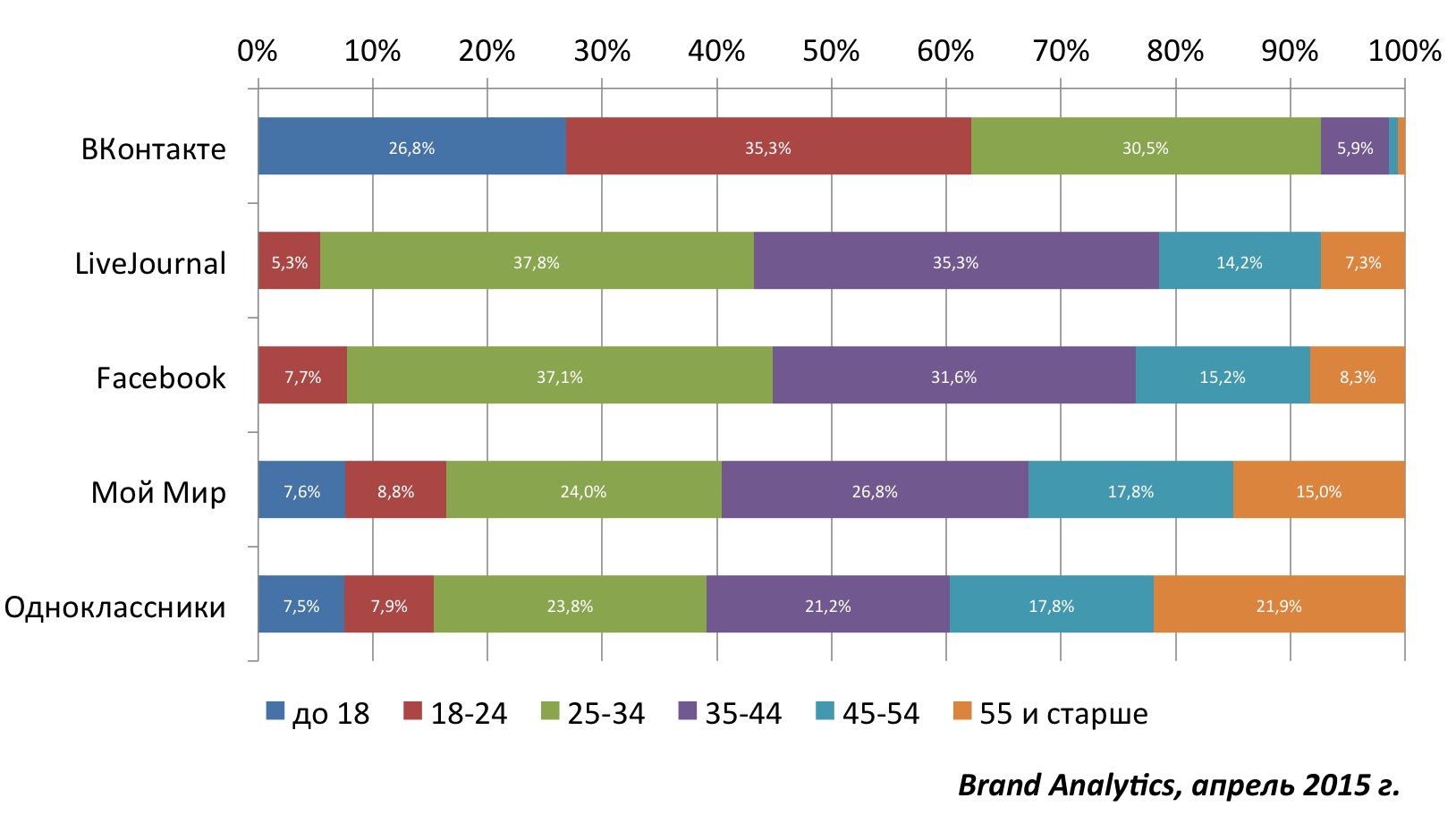
For Twitter and Instagram data on the age of active authors are missing.
The gender structure of social networks is dominated by women, especially their role on Instagram (77.4% of the active audience) and Odnoklassniki (69.2% of the authors) is especially large. LiveJournal remains the only “male” network (the proportion of men here = 57.2%), Twitter came to gender equality in the spring.
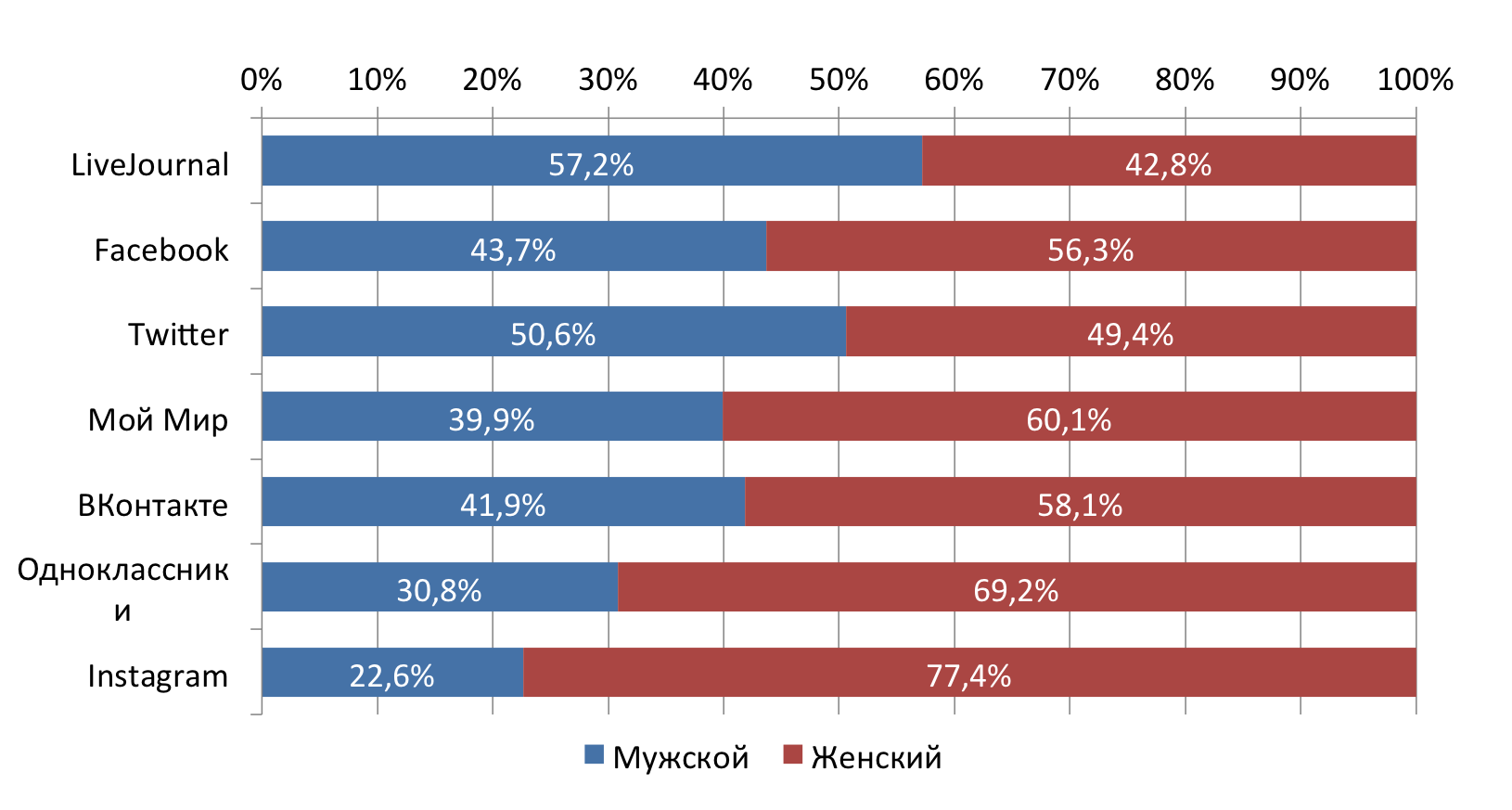
The main trend of the first half of 2015 is the reduction of Twitter speaking audience by more than 20%.
The age structure of the active audience has stabilized: in most social networks, there is a strengthening of the core position “from 25 to 34 years old”, Odnoklassniki have become much older over the past six months.
The gender distribution of social media audiences is shifted towards women, and this shift is constantly deepening. The predominance of men is stored in LiveJournal, Twitter is catching up on it.
Indicative ratings of top authors and groups as a reflection of the interests of the audience of social networks. If VKontakte has record-breaking engagement is noted on the pages of teen video bloggers and in entertainment communities (jokes, lifehacks and secret revelations), then on Facebook the most popular pages are much more serious - here both personal accounts of deputies and journalists of the “Ukrainian theme” and corporate pages (for example, Dolce & Gabbana and Skyscanner).
In conclusion, we note the active development of alternative forms of social media - the volume of specialized thematic forums and reviews (banking and tourism resources, telecom, insurance, etc.) is growing significantly. Social media is constantly expanding its borders, going beyond traditional social networks - so, more and more user-generated content can be seen in the comments of online media.
** TNS Web Index, March 2015
*** Brand Analytics, April 2015
Number of public messages and authors
One of the key indicators of the “vital activity” of a social network is the number of “talking” users who openly express their position with public messages in social media. Such active authors in April 2015 in Russia were about 35 million people who generated almost 620 million messages in a month. Active authors, creating public content, make social networks a relevant indicator of public sentiment, allowing you to catch the "live" social problems at the very beginning of the formation of significant trends.
By the number of “writing” Russian authors, VKontakte leads, almost by an order of magnitude ahead of its competitors - 21.6 million unique authors. The following Instagram is on the second place - only 2.4 million authors (a decline in relation to the data of the past half year was 11%, the pre-New Year activity remained insurmountable peak height). The third place - Twitter - showed a significant drop (-24% by November 2014), speaking authors in April 2015 recorded only 1.6 million people.
')

* Data on the Odnoklassniki social network are based on statistics of the TOP 100.000 groups
As for the volume of content posted daily in social networks, here the first place belongs to the social network VKontakte, followed by Twitter.
It is worth noting that, compared with the trends of winter, where Twitter dominated, in the spring, VKontakte took revenge, having overtaken microblogs by 42%! This is due to the greater versatility of the VKontakte publication format - users not only record current moods in the form of short statuses (similar to tweets) on their pages, but also write detailed reports with photos and videos, share interesting news and useful tips.

* Data on the Odnoklassniki social network are based on statistics of the TOP 100.000 groups
Twitter is traditionally leading in terms of engagement - there is a machine-gun burst of 127 posts per month for one active author on this network. The second place - LiveJournal - lags behind by this indicator more than 3 times (on average, 40 messages per author): this is exactly the case when the quantity turns into quality. It is worth noting the explosive growth in the involvement of Facebook (a threefold increase compared to the winter data), which took 3rd place with 32 posts per month for the author. The level of involvement in other social networks ranges from 13.4 (VKontakte) to 6.3 (My World).

* Data on the Odnoklassniki social network are based on statistics of the TOP 100.000 groups
Monthly social media audience
According to TNS, the monthly audience of most social networks has stabilized. So, the VKontakte audience stopped at 53.6 million people, the second place went to Odnoklassniki ( 38.8 million people). Facebook audience in April was 24.5 million people, My World was close to it - 23.7 million people, Instagram audience in April was 10, 7 million people. Twitter showed a decline of 13% - its audience in April is 7.4 million .

* Twitter and Instagram data are extrapolated based on daily per day and frequency of visits per month.
Portrait of a social network user
In contact with
The monthly audience * - 53.6 million people , 40% of which - 21.6 million - showed public activity.

The gender structure of the VKontakte authors is fairly stable, 41.9% of the authors are male, the proportion of the weaker sex was 58.1% .

Compared with the December data, the age structure of the VKontakte audience has smoothed out - although the main backbone of users is also included in the category “from 18 to 24 years old”, their share decreased by 2.5 percentage points, while the groups of teenagers were replenished (+2.8%). . p.) and a mature contingent over 45 years of age (+1.4 pp).

| No | Region | Authors | % of population |
|---|---|---|---|
| Total in Russia | 21,558,786 | 14.80% | |
| one | St. Petersburg | 1,809,586 | 35.99% |
| 2 | Moscow | 3,142,917 | 26.24% |
| 3 | Murmansk region | 181 419 | 23.25% |
| four | Sevastopol | 88 002 | 22.92% |
| five | Kaliningrad region | 215,779 | 22.60% |
| 6 | Republic of Karelia | 142 603 | 22.39% |
| 7 | Vologodskaya Oblast | 244,984 | 20.48% |
| eight | Republic of Tatarstan (Tatarstan) | 772 325 | 20.21% |
| 9 | Arkhangelsk region | 233,765 | 20.16% |
| ten | Chelyabinsk region | 641 441 | 18.40% |
In general, the geographic slice of the VKontakte audience in the spring of 2015 follows the contours of winter - St. Petersburg ranks first with a network penetration rate of 36%, Moscow is second with 26% of the registered population. However, in most regions there is an alarming reduction in the penetration rate of the most popular Russian-language network. It is worth noting that the emergence of Sevastopol in the top five of the most "mastered" regions (4th place with 23% of the registered population).
Classmates
Classmates, as before, remain primarily a platform for interpersonal communication. The monthly audience * of the network is 39 million people , while only 1.4 million authors demonstrate public activity in groups .

Compared to the winter in April, the share of women in the Odnoklassniki gender structure has slightly decreased - however, the predominance of the weaker sex is still large (69.2% of women versus 20.8% of men).

In spring, Odnoklassniki retain the trend of “growing up” the audience: the share of authors older than 55 in April 2015 increased by 2.1 percentage points, the category “from 45 to 54 years old” increased by 0.8 percentage points, and the group “ from 35 to 44 years old "added 1.2 percentage points Users under 24 years old decreased by 4 percentage points. in the age structure of the network.

| No | Region | Authors | % of population |
|---|---|---|---|
| Total in Russia | 1,390,412 | 0.95% | |
| one | Sakhalin region | 11,764 | 2.38% |
| 2 | Jewish Autonomous Region | 3,404 | 1.97% |
| 3 | Khabarovsk region | 23 522 | 1.75% |
| four | Sevastopol | 6,207 | 1.62% |
| five | Transbaikal region | 17,792 | 1.62% |
| 6 | Khanty-Mansi Autonomous Area - Ugra | 24,542 | 1.55% |
| 7 | Yamalo-Nenets Autonomous District | 8,068 | 1.49% |
| eight | Amur region | 12,159 | 1.49% |
| 9 | Kaliningrad region | 13,980 | 1.46% |
| ten | Irkutsk region | 33,746 | 1.39% |
Classmates remain the "regional" social network of Russia: the first place in terms of network penetration, as before, belongs to the Sakhalin Region. Next come the Jewish Autonomous Region and the Khabarovsk Territory.
My world
The monthly audience of the network * was 23.6 million people , and the number of active authors was 1 million people .

The gender structure of My World has practically not changed, 39.9% of men and 60.1% of women.

In the age distribution of the authors of the My World network, there was a strengthening of middle age groups: the share of the category “from 25 to 34 years old” increased by 1.7 percentage points. , and the share of the category “from 35 to 44 years old” increased by 3.8 percentage points .

As before, the Chelyabinsk Region (1.67% of the population) is the leader in the rating of regions in terms of the penetration of the Moy Mir network, but in the spring Moscow pushed aside Sevastopol (1.32%) from second place.
| No | Region | Authors | % of population |
|---|---|---|---|
| Total in Russia | 1 904 709 | 1.31% | |
| one | Chelyabinsk region | 108 672 | 3.12% |
| 2 | Sevastopol | 9,467 | 2.47% |
| 3 | Moscow | 288,440 | 2.41% |
| four | Autonomous Republic of Crimea | 45,407 | 2.32% |
| five | Khabarovsk region | 27,707 | 2.06% |
| 6 | Krasnoyarsk region | 57,318 | 2.01% |
| 7 | Primorsky Krai | 38,913 | 2.00% |
| eight | St. Petersburg | 99,747 | 1.98% |
| 9 | Kaliningrad region | 18 856 | 1.97% |
| ten | Omsk region | 37,465 | 1.90% |
On Facebook, the share of writing authors in the general audience is consistently low: according to April, the monthly audience * of the network was 24.5 million people , of which 1.1 million people showed publication activity. Involvement of an active audience showed unprecedented growth in spring.

Spring shifted the gender distribution of the Russian-speaking part of Facebook towards the weaker sex ( 56.3% of the authors ).

In the age structure of Facebook, the position of the category “from 25 to 34 years old” has strengthened - their share has grown by another 2.2 percentage points. In general, the distribution of Russian-speaking authors of the network is fairly stable in age.

The geographical cut demonstrates stability - most regions retained their December positions: the only vivid exception here is Altai, which rose to second place in terms of Facebook penetration in Russia (3% of the population).
| No | Region | Authors | % of population |
|---|---|---|---|
| Total in Russia | 1,117,548 | 0.77% | |
| one | Moscow | 593,547 | 4.95% |
| 2 | Altai Republic | 6,275 | 2.98% |
| 3 | Yaroslavskaya oblast | 29,778 | 2.34% |
| four | St. Petersburg | 88 154 | 1.75% |
| five | Kaliningrad region | 10,846 | 1.14% |
| 6 | Republic of North Ossetia - Alania | 5,426 | 0.77% |
| 7 | Tomsk region | 7 346 | 0.69% |
| eight | Sverdlovsk region | 28,986 | 0.67% |
| 9 | Primorsky Krai | 11,741 | 0.60% |
| ten | Novosibirsk region | 15 981 | 0.59% |
Livejournal
LiveJournal remains a place for “to read, not to talk” lovers: out of 16.4 million people of a monthly audience *, only 123 thousand authors are active.

In LiveJournal, the male audience continues to grow - compared to the winter figures, the share of the stronger sex increased by 1.4 percentage points. Live Magazine can rightly be called the most male social network in Russia: blogs also mark the highest proportion of substantive discussions.

The age structure of LJ has stabilized and a bit “settled down” - the most popular category “from 25 to 34 years old” reduced its presence by 0.5 percentage points. The older groups, on the contrary, grew up: “from 35 to 44 years old” - by 2.1 percentage points, “from 44 to 54 years old” by 1.6 percentage points, and “over 55 years old” added 0.7 pp
Instagram, although it retains its superiority over Twitter, in April, slightly losing its position on the audience and the number of authors compared with the winter figures. The monthly audience of the network * was 10.6 million people , and the number of active authors was 2.4 million .

In April, the prevalence of the weaker sex on Instagram increased by almost 7 percentage points. Thus, this network can rightfully be called the most female among Russian-language social media.
Data on the age of active authors in Instagram is missing.

The level of penetration into Instagram almost did not change - Leningrad Oblast, Moscow, Sakhalin and Moscow Oblasts are still leading.
| No | Region | Authors | % of population |
|---|---|---|---|
| Total in Russia | 2,372,422 | 1.63% | |
| one | Leningrad region | 104 161 | 5.95% |
| 2 | Moscow | 675 155 | 5.64% |
| 3 | Sakhalin region | 22,241 | 4.51% |
| four | Moscow region | 200 913 | 2.85% |
| five | Yaroslavskaya oblast | 31,709 | 2.49% |
| 6 | St. Petersburg | 120 496 | 2.40% |
| 7 | Krasnodar region | 124 989 | 2.34% |
| eight | Kaliningrad region | 21,685 | 2.27% |
| 9 | Khabarovsk region | 30,374 | 2.26% |
| ten | Primorsky Krai | 43 935 | 2.26% |
If you compare with December, in the spring, Twitter passed the position in Russia. In April, the resource audience * amounted to 7.4 million people , and the number of active authors was 1.6 million .

Interestingly, in April 2015, in comparison with the winter data, the palm moved to the side of the stronger sex (the share of the male audience increased to 50.6%).
Data on the age of active authors on Twitter is missing.

In terms of Twitter penetration leadership returned St. Petersburg. Also in the current ranking in the top three broke Novosibirsk and Novgorod region, and Moscow did not even hit the TOP-5.
| No | Region | Authors | % of population |
|---|---|---|---|
| Total in Russia | 1,596,471 | 1.10% | |
| one | St. Petersburg | 147,611 | 2.94% |
| 2 | Novosibirsk region | 52 789 | 1.95% |
| 3 | Novgorod region | 11,674 | 1.87% |
| four | Chukotka Autonomous Region | 875 | 1.72% |
| five | Sakhalin region | 8,267 | 1.68% |
| 6 | Samara Region | 54,045 | 1.68% |
| 7 | Kaliningrad region | 15 914 | 1.67% |
| eight | Omsk region | 32 697 | 1.66% |
| 9 | Moscow | 194,627 | 1.62% |
| ten | Yaroslavskaya oblast | 19 347 | 1.52% |
Comparison of socio-demographic characteristics of the authors
Age of authors
VKontakte remains the youngest and most dynamic social network: almost 2/3 of the authors of this network are under 25 years old. The share of the mature contingent "45 and older" accounts for only 1.4% of the active audience, the authors from 35 to 44 years old make up only 6% of the "writing" users. The core of this social network is the age group “from 18 to 24 years old” - 35.3% of the authors.
Traditionally, the most adult Odnoklassniki network has become even older: authors under the age of 25 are only 15%, the core of the active audience is 24-44 years and already 22% of the active audience falls into the category "55 and older."

For Twitter and Instagram data on the age of active authors are missing.
Gender of the authors
The gender structure of social networks is dominated by women, especially their role on Instagram (77.4% of the active audience) and Odnoklassniki (69.2% of the authors) is especially large. LiveJournal remains the only “male” network (the proportion of men here = 57.2%), Twitter came to gender equality in the spring.

Trends and forecasts
The main trend of the first half of 2015 is the reduction of Twitter speaking audience by more than 20%.
The age structure of the active audience has stabilized: in most social networks, there is a strengthening of the core position “from 25 to 34 years old”, Odnoklassniki have become much older over the past six months.
The gender distribution of social media audiences is shifted towards women, and this shift is constantly deepening. The predominance of men is stored in LiveJournal, Twitter is catching up on it.
Indicative ratings of top authors and groups as a reflection of the interests of the audience of social networks. If VKontakte has record-breaking engagement is noted on the pages of teen video bloggers and in entertainment communities (jokes, lifehacks and secret revelations), then on Facebook the most popular pages are much more serious - here both personal accounts of deputies and journalists of the “Ukrainian theme” and corporate pages (for example, Dolce & Gabbana and Skyscanner).
In conclusion, we note the active development of alternative forms of social media - the volume of specialized thematic forums and reviews (banking and tourism resources, telecom, insurance, etc.) is growing significantly. Social media is constantly expanding its borders, going beyond traditional social networks - so, more and more user-generated content can be seen in the comments of online media.
** TNS Web Index, March 2015
*** Brand Analytics, April 2015
Source: https://habr.com/ru/post/291390/
All Articles